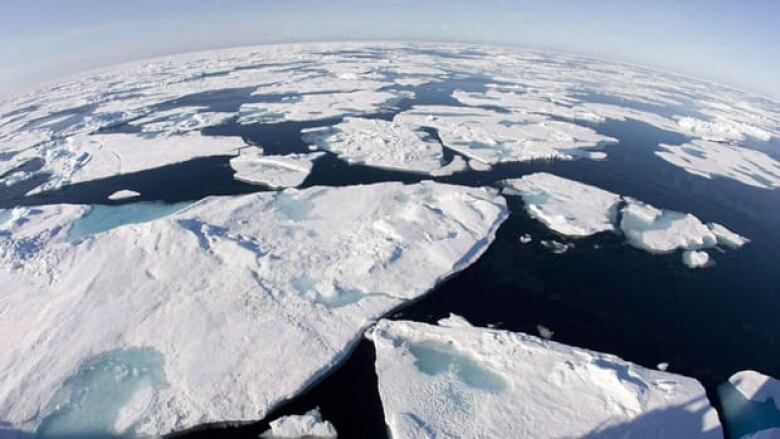Competition heats up to build Canada's first Arctic fibre line, as Inuit want in
Latest proposal would see fibre line through the Northwest Passage, from Labrador to the N.W.T.

High-speedfibre-optic internetcould finally be coming to Nunavut, with two groups now competing to run subsea cables through the Arctic archipelago.
For the past year, Nunavut Resource Corporation, which is partly owned by the Kitikmeot Inuit Association,has been lobbying the federal government forsupport for a new $850-million plan tobuildonto existing fibreoptic networks in Labrador, Quebecand the N.W.T.
Its vision: to createa giant loop across the North, tying the cables to the continental internetgrid via the fibre linerunning up the Mackenzie Valley to Inuvikon onesideand to Chisasibiin JamesBay, Quebec, on the other.
"I'd say it'smore promising than the Arctic Fibre project which we all know about and was hyped pretty significantly," says Nunavut senator Dennis Patterson, referring to an earlier plan to bring fibre optic internet to Nunavut via a 15,000-kilometresubsea cable from Europe to Asia.
Both plans are much needed: right now, many Canadian Arctic communities rely on a single satellite for internetand telephoneservice, a system whose fragility was once again on display during a 19-hour satellite outage that knocked out service to much of Nunavut andnorthern Quebecearlier this month.
- Phone, internet services back up after Telesat satellite issue in Northern Canada
- FROM 2011 |Satellite outage caught communities unprepared
4 Inuit organizations need $500M
The rival Nunavut Resources Corporation network would be owned by the four Inuit birthright organizations the KIA, plus the Kivalliqand Qikiqtani(Baffin region) Inuit associations and the umbrella Nunavut TunngavikInc. organization and is intended to be financedthrough a combination of federal infrastructure grants and private investment.
"Having an Inuit-owned venture should appeal to a new federal government that's talking about engaging with Aboriginal people and working in partnership with Aboriginal people on economic development projects," adds Patterson.
If the Inuitgroupscansecure around $500 million from the government, or 60 per cent of the project's costs, Nunavut Resources Corporation'steam can"build a business case that would make it a sustainable long term operation," says ScottNorthey, the company'schief operating officer.
He says that's because Nunavut's reliance on satellite internetis already costing governments and businesses money, pointing to the example that whileall the health facilities inNunavuthavetelehealthcapacity:"They can't actuallyemailthe x-raysand so instead they have to fly all these people out."
Where's Arctic Fibre?
The new proposalcomes on the heels of the first major expansion of the continental fibre grid into the far North, over on the U.S. side of the border.

The company behind the project, Quintillion, acquired Canadian company Arctic Fibre earlier this year, and says itstill has sights set on Canada.
"The first phase is six landings in Alaska, the second phase is the extension of the network into Japan, and then the third phase is through Canada and the communities in Canada over to Europe," said Michael Cunningham, former CEO of Arctic Fibre, now a Quintillion board member.
He didn't offer any timelines for when the Canadian phase of the project might proceed, but he was skeptical of other groups competing for a similar project.
"Subsea projects in general are challenging to finance, and add on the execution risk of an Arctic project and it's a very challenging undertaking. We raised the money to go and do it," he says.
Three years ago, Cunningham saidArctic Fibre hadsecured $620 million in private financing for the project. He says that financing is still in place post-acquisition, and the Quintillion partnership is bringing significantly more resources to the project.
Documents filed with the U.S. Federal Communications Commission show that the project is backed by relatives of billionaire Leonard Blavatnik, currently the 53rd richest man in the world.
"I think that for any project to be viable and not to end in tears it's got to be really executed by experienced people and that's really the reason why undoubtedly we will be the ones who end up building to Canada," says Cunningham
'Acyber highway'
"I wouldn't rule out Quintillion,"says Patterson."If they're going to be able to do it, that'll be great.But it's pretty clear they're focusing on Alaska."
As for his favoured project:"It's early stages," says Patterson.
"But they've gotcommitments from theNunatsiavutgovernmentin Labrador, the Inuit government there. They've got commitments fromNunavikin Northern Quebec. They've got commitments from the Government ofNunavutand Inuit organizations all along the way."
In Ottawa,he and othersare actively lobbying the federal government.
The first majorhurdle, says Patterson, is convincing the government to change how it allocates infrastructure funding, and allowtelecomprojects to apply for a bigger slice of the $120 billion promised by theLiberal governmentover the next 10 years.
"We got to realize thatCanadawas built by highways... and by railways, and it's our turn in the North and our highway is going to be a cyber highway," he says.
At leasttwo years
Northey of Nunavut Resources Corporationhopesthe government will announce support for the project as early as the 2017 budget.
But he added thathe'llbe"shocked if it took us less than two years to get to the point where we're ready to hire people to start laying cable."
A spokespersonfor Infrastructure Canada told the CBC, viaemail, that"details of the [government's infrastructure]plan will be announced in the coming months."












_(720p).jpg)


 OFFICIAL HD MUSIC VIDEO.jpg)
.jpg)



























































































